Carbon Neutrality and Resilient Districts, a Common Strategy in European Union Countries in 2050
Abstract
1. Introduction
2. A Review
3. Methodology
3.1. District Selection
3.1.1. Sustainable Neighborhood, a Case of Sart-Tilman City
3.1.2. Urban Neighborhood: Maghin
3.1.3. Rural Neighborhood in Neupre
3.2. Design Modelling and Assumptions
- (a)
- War and Peace Assumption: We acknowledge that a country’s carbon emissions can vary significantly between wartime and peacetime. To maintain consistency, we assumed that all studied countries were in a state of peace, with no ongoing wars or conflicts affecting energy consumption or emissions.
- (b)
- Energy Mix Consideration: The energy mix varies between countries, influencing overall carbon emissions and energy demand. To account for this variability, we used data from the International Energy Agency (IEA).
- (c)
- Climate Data Collection: To evaluate the climatic conditions of each country, we used the latest version of the Meteonorm software suite. This tool provides reliable climate data by accessing an American satellite database, using the geographical coordinates of each city. The Meteonorm database covers 6200+ cities and 8325+ weather stations worldwide. This software has been validated by researchers globally and has contributed to several scientific publications.
- (d)
- Transportation and Mobility Assumptions: The daily transportation patterns of occupants were simulated based on each country’s geolocation. The software applied standardized data, assuming 80% of daily mobility concentration for all countries; a home-to-shop distance of 1000 m; a home-to-public transport network distance of 500 m; a home-to-work distance between 5000 m and 20,000 m; a 5-day workweek, with travel occurring 47 weeks per year; and the main modes of public transport being trams, buses, and metro systems. Occupants were assumed to be in good health, with standardized activity patterns across different neighborhood categories.
- (e)
- Water and Waste Assumptions: For water consumption, we assumed a water system efficiency of 80%. Regarding waste generation, we estimated that each person produces 0.8 to 1.2 kg of waste per day.
- (f)
- Embodied Energy Calculation
3.3. Database
3.4. Simulation Software
3.4.1. Process
3.4.2. Components
3.5. Scenarios
- (1)
- Initial Scenario
- Day Zone:
- ○
- 22:00–07:00: 16 °C
- ○
- 07:00–22:00: 19 °C
- Night Zone:
- ○
- 22:00–07:00: 18 °C
- ○
- 07:00–22:00: 16 °C
- (2)
- Ventilation and Air-Tightness Parameters
- (3)
- Scenario Analysis
- Renovation measures included insulating attics, walls, and floors; installing high-efficiency heating systems in countries with temperate climates.
- Solar PV panels were installed on all building roofs.
- All public and private transportation was assumed to be fully sustainable.
- A new simulation was carried out, producing new insight.
3.6. Building/Neighborhood Data
3.7. Cost
4. Results
4.1. Validation of Results
4.2. Simulation of Initial Neighborhoods
4.2.1. Environmental Impact Analysis
4.2.2. Environmental Cost Analysis
4.3. Prediction in 2050
4.3.1. Environmental Impact Analysis
4.3.2. Environmental Cost Analysis
4.4. Mitigation Strategies: Impacts of Photovoltaic Panel
4.4.1. Environmental Impact Analysis
4.4.2. Environmental Cost Analysis
4.5. Mitigation Strategies: Mixed Scenario
5. Discussion
5.1. Analysis and Comparison
5.1.1. Confrontation Between Environmental Impacts from Initial Districts
- Emissions due to heating represent only two-thirds of emissions due to the production of DHW.
- Emissions resulting from the movement of inhabitants make up nearly half of the emissions during the use phase. These features are primarily due to the fact that the excellent thermal efficiency of our structures significantly lowers their heating needs. Now, when we examine the “primary energy requirement” impact, the use phase remains dominant (96% of the overall energy demand), mainly because it includes mobility and waste disposal.
5.1.2. Confrontation Between Environmental Impacts from Future Districts
5.1.3. Confrontation of Environmental Impacts After Applying PV Panels
5.1.4. Summarize of Scenario
5.2. Adaptation and Mitigation Strategies
5.3. Policies
5.4. Sensitivity Analysis
5.5. Limitations
- (a)
- It is difficult to predict the future with exact accuracy;
- (b)
- The urban morphology varies from one country to another;
- (c)
- The energy mix of each country can vary at any period;
- (d)
- Occupant behavior is difficult to quantify;
- (e)
- Economic and population growth are different in each of these countries;
- (f)
- Strategies of waste treatment are not the same in all European countries;
- (g)
- Moving mode and population daily mobility vary from one country to another;
- (h)
- It is certain that by combining wind turbines and solar panels, it was easier to achieve carbon neutrality in the neighborhoods. This work will be the subject of the next study.
6. Conclusions
Author Contributions
Funding
Institutional Review Board Statement
Informed Consent Statement
Data Availability Statement
Acknowledgments
Conflicts of Interest
References
- Neutralité Carbone 2050: Des Efforts à Accélérer Pour l’UE. 2021. Available online: https://www.vie-publique.fr/en-bref/278834-neutralite-carbone-2050-des-efforts-accelerer-pour-lue (accessed on 10 January 2023).
- United Nation: Achieving Carbon Neutrality by 2050 is the Absolute Urgency, Says António Guterres. 2023. Available online: https://news.un.org/fr/story/2020/12/1084402 (accessed on 10 January 2023).
- What is Carbon Neutrality and How Can It Be Achieved by 2050? Available online: https://www.europarl.europa.eu/news/en/headlines/society/20190926STO62270/what-is-carbon-neutrality-and-how-can-it-be-achieved-by-2050 (accessed on 15 January 2023).
- Pulselli, R.M.; Broersma, S.; Martin, C.L.; Keeffe, G.; Bastianoni, S.; van den Dobbelsteen, A. Future city visions. The energy transition towards carbon-neutrality: Lessons learned from the case of Roeselare, Belgium. Renew. Sustain. Energy Rev. 2021, 137, 110612. [Google Scholar] [CrossRef]
- Laski, J.; Burrows, V. From Thousands to Billions: Coordinated Action towards 100% Net-Zero Carbon Buildings by 2050. 2017. Available online: https://worldgbc.org/article/from-thousands-to-billions-coordinated-action-towards-100-net-zero-carbon-buildings-by-2050/ (accessed on 15 January 2023).
- Shirinbakhsh, M.; Harvey, L.D. Net-zero energy buildings: The influence of definition on greenhouse gas emissions. Energy Build. 2021, 247, 111118. [Google Scholar] [CrossRef]
- Too, J.; Ejohwomu, O.A.; Hui, F.K.; Duffield, C.; Bukoye, O.T.; Edwards, D.J. Framework for standardising carbon neutrality in building projects. J. Clean. Prod. 2022, 373, 133858. [Google Scholar] [CrossRef]
- Nematchoua, M.K.; Sadeghi, M.; Sigrid, R. Strategies and scenarios to reduce energy consumption and CO2 emission in the urban, rural and sustainable neighbourhoods. Sustain. Cities Soc. 2021, 72, 103053. [Google Scholar] [CrossRef]
- Mirabella, N.; Röck, M.; Ruschi Mendes Saade, M.; Spirinckx, C.; Bosmans, M.; Allacker, K.; Passer, A. Strategies to improve the energy performance of buildings: A review of their life cycle impact. Buildings 2018, 8, 105. [Google Scholar] [CrossRef]
- Jain, S.; Agarwal, A.; Jani, V.; Singhal, S.; Sharma, P.; Jalan, R. Assessment of carbon neutrality and sustainability in educational campuses (CaNSEC): A general framework. Ecol. Indicat. 2017, 76, 131–143. [Google Scholar] [CrossRef]
- Ray, G. Net-zero-energy buildings or zero-carbon energy systems? How best to decarbonize Germany’s thermally inefficient 1950s-1970s-era apartments. J. Build. Eng. 2022, 54, 104671. [Google Scholar]
- Peuportier, B.; Popovici, E.; Troccmé, M. Analysedu cycle de vie à l’échelle du quartier, bilan et perspectives du projet ADEQUA. Build. Environ. 2013, 3, 17. [Google Scholar]
- Goedkoop, M.; Spriensma, R. The Eco-Indicator 99: A Damage Oriented Method for Life Cycle Impact Assessment; PRé Consultants B.V.: Amersfoort, The Netherlands, 2000; p. 142. [Google Scholar]
- Kennedy, S.; Sgouridis, S. Rigorousclassification and carbon accounting principles for low and zero carbon cities. Energy Policy 2011, 39, 5259–5268. [Google Scholar] [CrossRef]
- Nematchoua, M.K.; Somayeh, A.; Reiter, S. Influence of energy mix on the life cycle of an eco-neighborhood, a case study of 150 countries. Renew. Energy 2020, 162, 81–97. [Google Scholar] [CrossRef]
- Chen, L.; Msigwa, G.; Yang, M.; Osman, A.I.; Fawzy, S.; Rooney, D.W.; Yap, P.S. Strategies to achieve a carbon neutral society: A review. Environ. Chem. Lett. 2022, 20, 2277–2310. [Google Scholar] [CrossRef] [PubMed]
- Maximillian, J.; Brusseau, M.L.; Glenn, E.P.; Matthias, A.D. Pollution and environmental perturbations in the global system. In Environmental and Pollution Science; Academic Press: Cambridge, MA, USA, 2019; pp. 457–476. [Google Scholar] [CrossRef]
- Yang, M.; Chen, L.; Msigwa, G.; Tang, K.H.D.; Yap, P.-S. Implications of COVID-19 on global environmental pollution and carbon emissions with strategies for sustainability in the COVID-19 era. Sci. Total Environ. 2022, 809, 151657. [Google Scholar] [CrossRef] [PubMed]
- Modeste, K.N.; Rakotomalala, M.S.; Charline, M.; Jose AOrosa, E.S.; Sigrid, R. Analysis of environmental impacts and costs of a residential building over its entire life cycle to achieve nearly zero energy and low emission objectives. J. Clean. Prod. 2022, 373, 133834. [Google Scholar]
- Modeste, K.N.; Orosa, J.A. Life cycle assessment of radioactive materials from a residential neighbourhood. Sustain. Mater. Technol. 2022, 33, e00468. [Google Scholar]
- Arshian, S.; Syed Ali, R.; Ilhan, O.; Sahar, A. The dynamic relationship of renewable and nonrenewable energy consumption with carbon emission: A global study with the application of heterogeneous panel estimations. Renew. Energy 2019, 133, 685–691. [Google Scholar]
- Li, H.-S.; Geng, Y.-C.; Shinwari, R.; Yangjie, W.; Rjoub, H. Does renewable energy electricity and economic complexity index help to achieve carbon neutrality target of top exporting countries? J. Environ. Manag. 2021, 299, 113386. [Google Scholar] [CrossRef]
- Zhao, X.; Ma, X.; Chen, B.; Shang, Y.; Song, M. Challenges toward carbon neutrality in China: Strategies and countermeasures. Resour. Conserv. Recycl. 2022, 176, 105959. [Google Scholar] [CrossRef]
- Osman, A.I.; Chen, L.; Yang, M.; Msigwa, G.; Farghali, M.; Fawzy, S.; Yap, P.S. Cost, environmental impact, and resilience of renewable energy under a changing climate: A review. Environ. Chem. Lett. 2023, 21, 741–764. [Google Scholar] [CrossRef]
- Nematchoua, M.K.; Asadi, S.; Reiter, S. Estimation, analysis and comparison of carbon emissions and construction cost of the two tallest buildings located in United States and China. Int. J. Environ. Sci. Technol. 2022, 19, 9313–9328. [Google Scholar] [CrossRef]
- Allacker, K.; Maia, S.D.; Serenella, S. Land use impact assessment in the construction sector: An analysis of LCIA models and case study application. Int. J. Life Cycle Assess 2014, 19, 1799–1809. [Google Scholar] [CrossRef]
- Lotteau, M.; Loubet, P.; Pousse, M.; Dufrasnes, E.; Sonnemann, G. Critical review of life cycle assessment (LCA) for the built environment at the neighborhood scale. Build. Environ. 2015, 93, 165–178. [Google Scholar] [CrossRef]
- Leo De Nocker, V.I.T.O. VITO-WimDebacker, Annex: Monetisation of the MMG Method (Update 2017); Elsevier: Amsterdam, The Netherlands, 2018; pp. 1–65. [Google Scholar]
- Colombert, M.; De Chastenet, C.; Diab, Y.; Gobin, C.; Herfray, G.; Jarrin, T.; Bruno, P.; Charlotte, T.; Maxime, T. Analyse de cycle de vie à l’échelle du quartier: Un outil d’aide à la décision? Le cas de la ZAC Claude Bernard à Paris (France). Environ. Urbain/Urban Environ. 2011, 5, 1–21. [Google Scholar]
- De Nocker, L.; Broekx, S.; Liekens, I. Economische Waardering van Verbetering Ecologische Toestand Oppervlaktewater op Basis van Onderzoeksresultaten uit Aquamoney; Vito Intern Rapport 2011/RMA/R/248; Vito: Mol, Belgium, 2011; p. 58. [Google Scholar]
- Trigaux, D.; Allacker, K.; De Troyer, F. Life cycle assessment of land use in neighborhoods. Procedia Environ. Sci. 2017, 38, 595–602. [Google Scholar] [CrossRef]
- Ma, M.; Zhou, N.; Feng, W.; Yan, J. Challenges and opportunities in the global net-zero building sector. Cell Rep. Sustain. 2024, 1, 100154. [Google Scholar] [CrossRef]
- Meteonorm. 2024. Available online: https://meteonorm.com/en/meteonorm-version-8 (accessed on 14 April 2024).
- Nematchoua, M.K.; Teller, J.; Reiter, S. Statistical life cycle assessment of residential buildings in a temperate climate of northern part of Europe. J. Clean. Prod. 2019, 229, 621–631. [Google Scholar] [CrossRef]
- Nematchoua, M.K.; Jose, A.O.; Reiter, S. Life cycle assessment of two sustainable and old neighbourhoods affected by climate change in one city in Belgium: A review. Environ. Impact Assess. Rev. 2019, 78, 106282. [Google Scholar] [CrossRef]
- Nematchoua, M.K.; Reiter, S. Analysis, reduction and comparison of the life cycle environmental costs of an eco-neighborhood in Belgium. Sustain. Cities Soc. 2019, 48, 101558. [Google Scholar] [CrossRef]
- Urban Green-Blue Grids. Hammarby Sjöstad, Stockholm, Sweden. Available online: https://urbangreenbluegrids.com/projects/hammarby-sjostad-stockholm-sweden (accessed on 16 April 2025).
- Wati, E.; Meukam, P.; Nematchoua, M.K.; Rene, T. Influence of external shading on optimum insulation thickness of building walls in a tropical region. Appl. Therm. Eng. 2015, 90, 754–762. [Google Scholar] [CrossRef]
- Eurostat. Available online: https://ec.europa.eu/eurostat/web/interactive-publications/energy-2025 (accessed on 8 January 2023).
- Nick, V.; Mata, E.; Sasic, K.; Scartezzini, J. Effective and robust energy retrofitting measures for future climatic conditions—Reduced heating demand of Swedish households. Energy Build. 2016, 127, 12–24. [Google Scholar] [CrossRef]
- Ciobanu, D.; Eftimie, E.; Jaliu, C. The influence of measured/simulated weather data on evaluating the energy need in buildings. Energy Proc. 2014, 48, 796–805. [Google Scholar] [CrossRef]
- EPN 15978; Contribution des Ouvrages de Construction au Developpement Durable-Evaluation de la Performance Environnementale des Bâtiments-Methode de Calcul. Comite Europeen de Normalisation: Brussels, Belgium, 2011.
- Osman, A.I.; Mehta, N.; Elgarahy, A.M.; Al-Hinai, A.; Al-Muhtaseb AA, H.; Rooney, D.W. Conversion of biomass to biofuels and life cycle assessment: A review. Environ. Chem. Lett. 2021, 19, 4075–4118. [Google Scholar] [CrossRef]
- Schoonschip Amsterdam. Schoonschip Amsterdam. Available online: https://schoonschipamsterdam.org/en (accessed on 16 April 2025).
- Attia, S.; Mlecnik, E.; Van Loon, S. Principles for Nearly Zero Energy Building in Belgium. World Sustainable Energy Days. 2012. Available online: https://repository.tudelft.nl/record/uuid:64362f4c-f3a9-407a-9e98-b7a175de6238 (accessed on 22 April 2025).
- Modeste Kameni, N.; Antoinette Marie-Reine, N.; Sigrid, R. Towards nearly zero-energy residential neighbourhoods in the European Union: A case study. Renew. Sustain. Energy Rev. 2021, 135, 110198. [Google Scholar]
- Modeste Kameni, N.; Sigrid, R. Evaluation of bioclimatic potential, energy consumption, CO2-emission, and life cycle cost of a residential building located in Sub-Saharan Africa; a case study of eight countries. Sol. Energy 2021, 218, 512–524. [Google Scholar]
- Modeste, K.N. From existing neighbourhoods to net-zero energy and nearly zero carbon neighbourhoods in the tropical regions. Sol. Energy 2020, 211, 244–257. [Google Scholar]
- Reusswig, F.; Bock, S.; Schleer, C.; Lass, W. Effects of voluntary and involuntary real lab situations on personal carbon foot-prints of private households. Exp. Ger. Front. Sustain. 2021, 2, 648433. [Google Scholar] [CrossRef]
- Modeste, K.N. A simplified framework to assess the feasibility of zero-energy at the European community scale in 2030. Sol. Energy 2021, 230, 1040–1051. [Google Scholar]
- Fawzy, S.; Osman, A.I.; Doran, J.; Rooney, D.W. Strategies for mitigation of climate change: A review. Environ. Chem. Lett. 2020, 18, 2069–2094. [Google Scholar] [CrossRef]
- Enviropaul. Kronsberg: A Model Neighborhood in Germany. 3 January 2018. Available online: https://enviropaul.wordpress.com/2018/01/03/kronsberg-a-model-neighborhood-in-germany (accessed on 16 April 2025).
- Nematchoua, M.K.; Reiter, S. Life cycle assessment of an eco-neighborhood: Influence of a sustainable urban mobility and photovoltaic panels. In Proceedings of the IAPE’19, Oxford, UK, 15 March 2019. [Google Scholar]
- Barbara, R.; Anne-Françoise, M.; Sigrid, R. Life-cycle assessment of residential buildings in three different European locations, basic tool. Build. Environ. 2012, 51, 395–401. [Google Scholar]
- Grafakos, S.; Trigg, K.; Landauer, M.; Chelleri, L.; Dhakal, S. Analytical framework to evaluate the level of integration of climate adaptation and mitigation in cities. Clim. Chang. 2019, 154, 87–106. [Google Scholar] [CrossRef]
- Mustafa, A.; Kazmi, M.; Khan, H.R.; Qazi, S.A.; Lodi, S.H. Towards a carbon neutral and sustainable campus: Case study of NED university of engineering and technology. Sustainability 2022, 14, 794. [Google Scholar] [CrossRef]
- Finnveden, G.; Hauschild, M.Z.; Ekvall, T.; Guinée, J.; Heijungs, R.; Hellweg, S.; Koehler, A.; Pennington, D.; Suh, S. Recent developments in life cycle assessment. J. Environ. Manag. 2009, 91, 1–21. [Google Scholar] [CrossRef] [PubMed]
- Horne, R.E.; Grant, T.; Verghese, K. Life Cycle Assessment: Principles, Practice and Prospects; CSIRO Publishing: Clayton, Australia, 2009. [Google Scholar] [CrossRef]
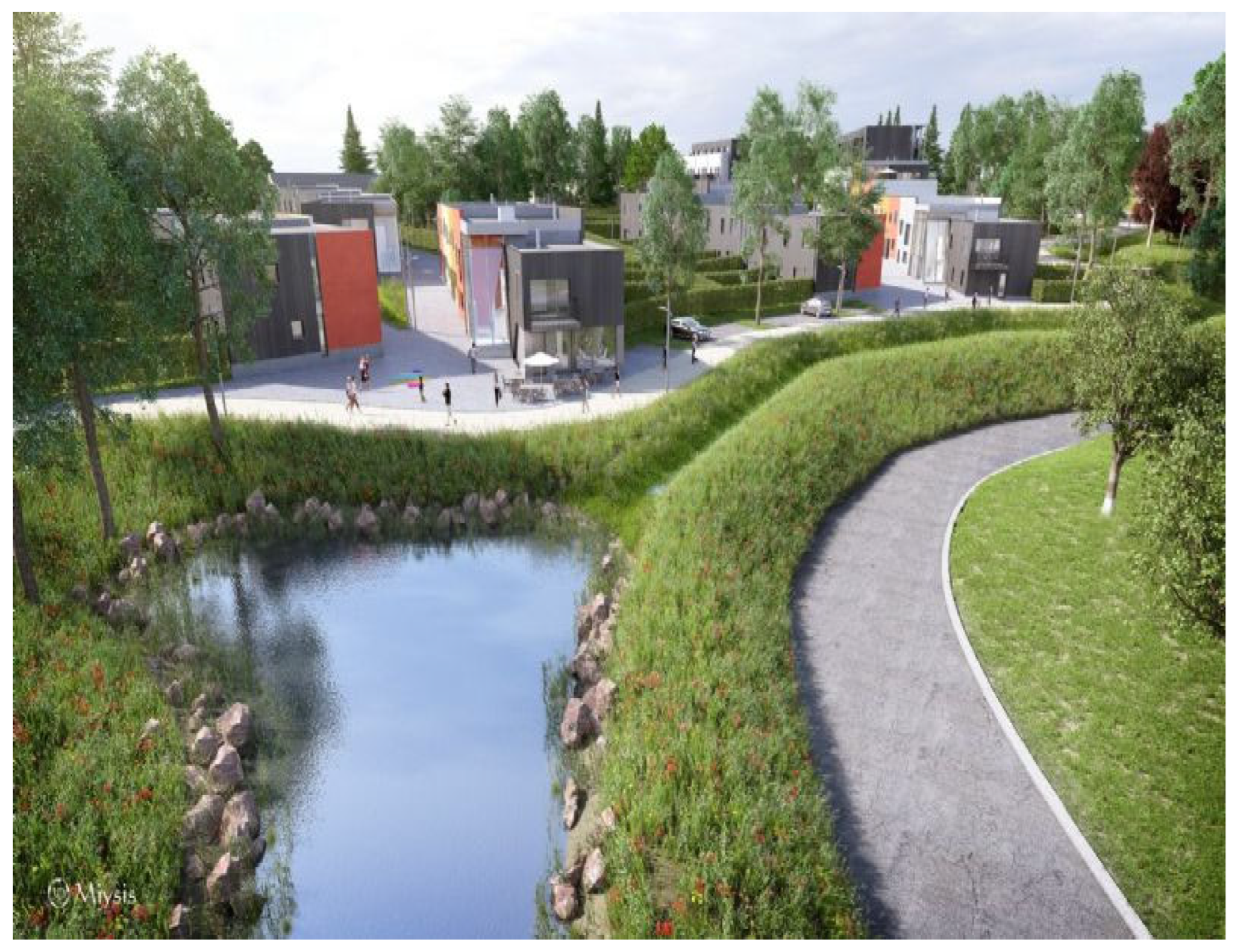

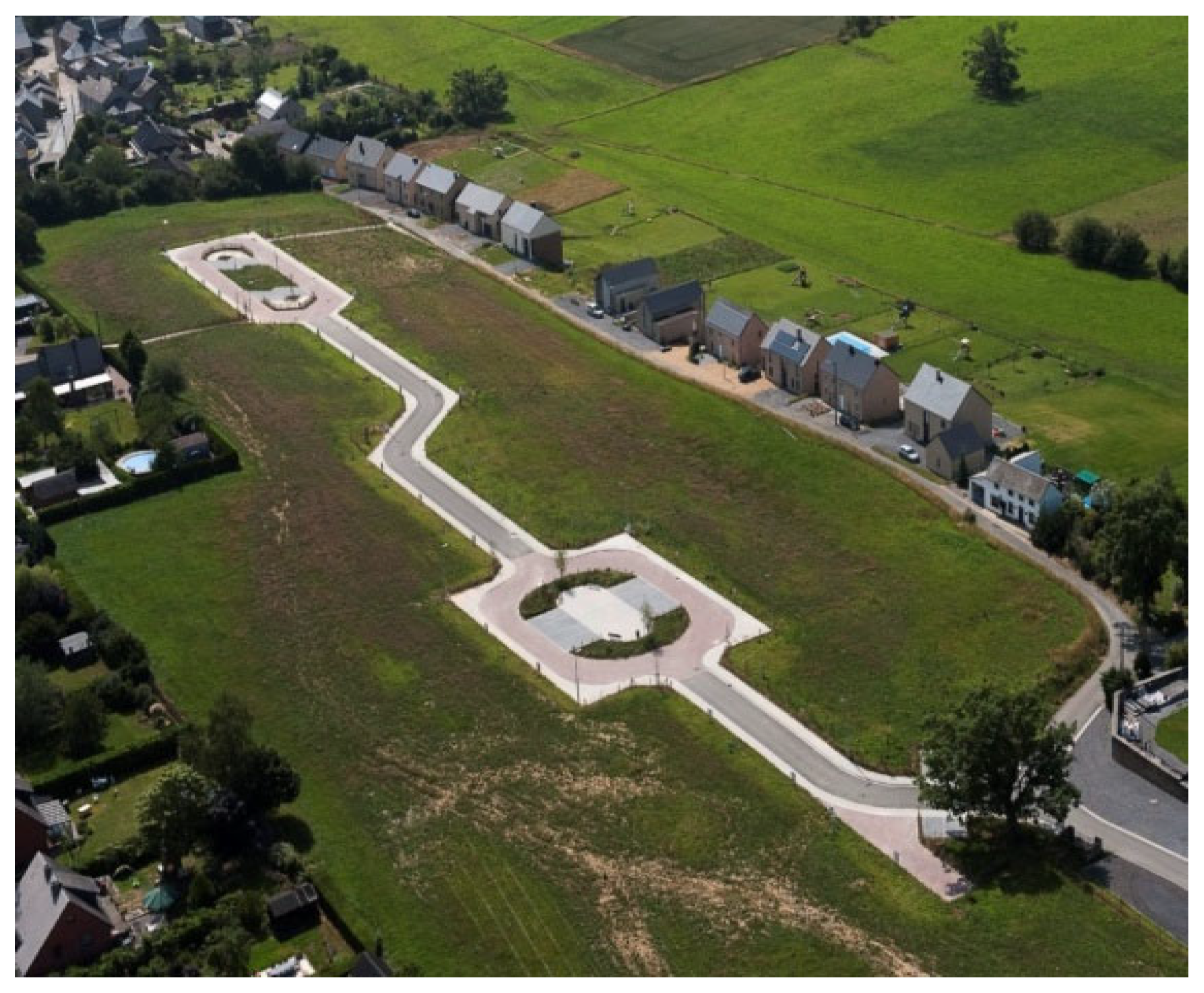

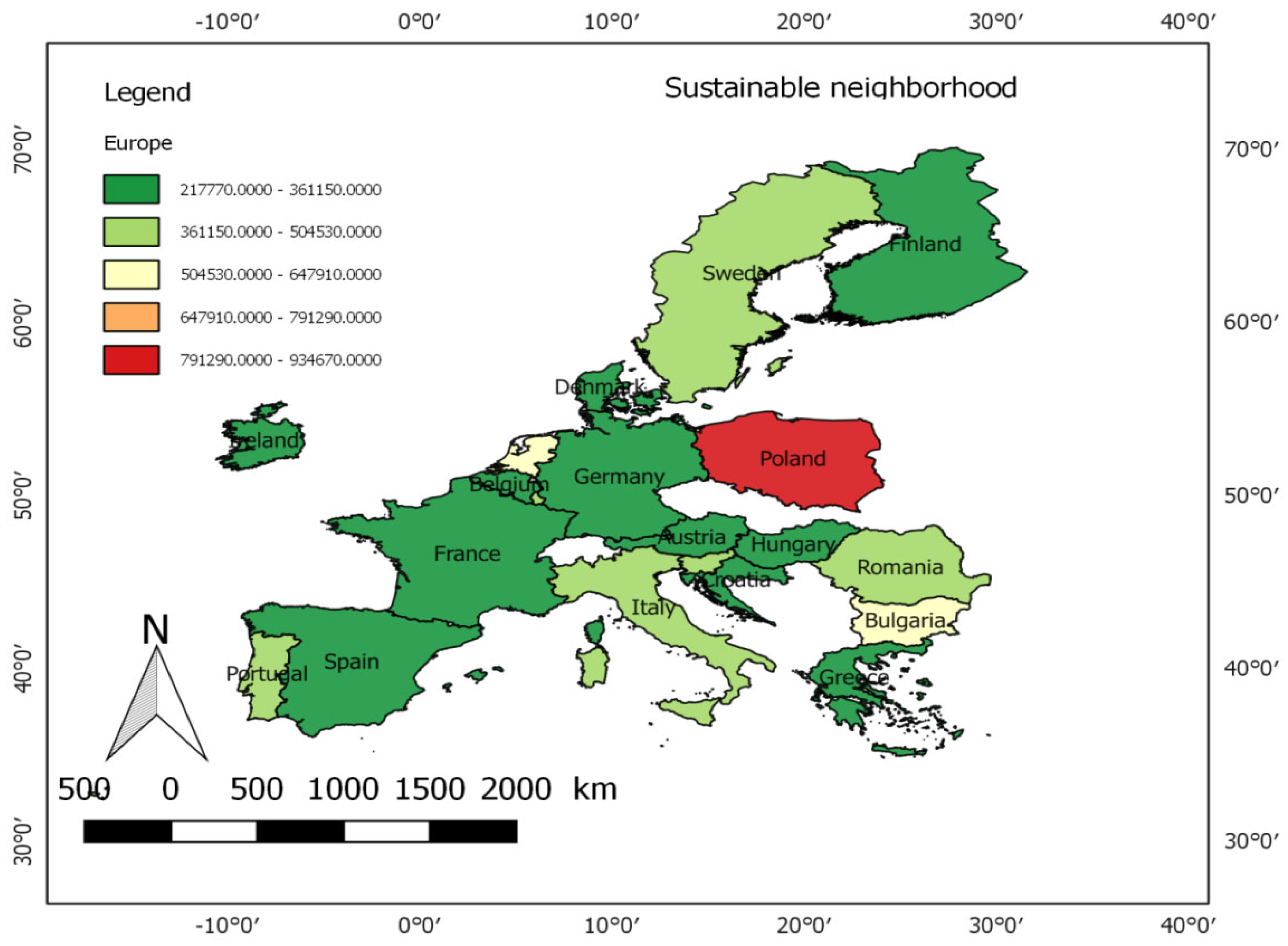

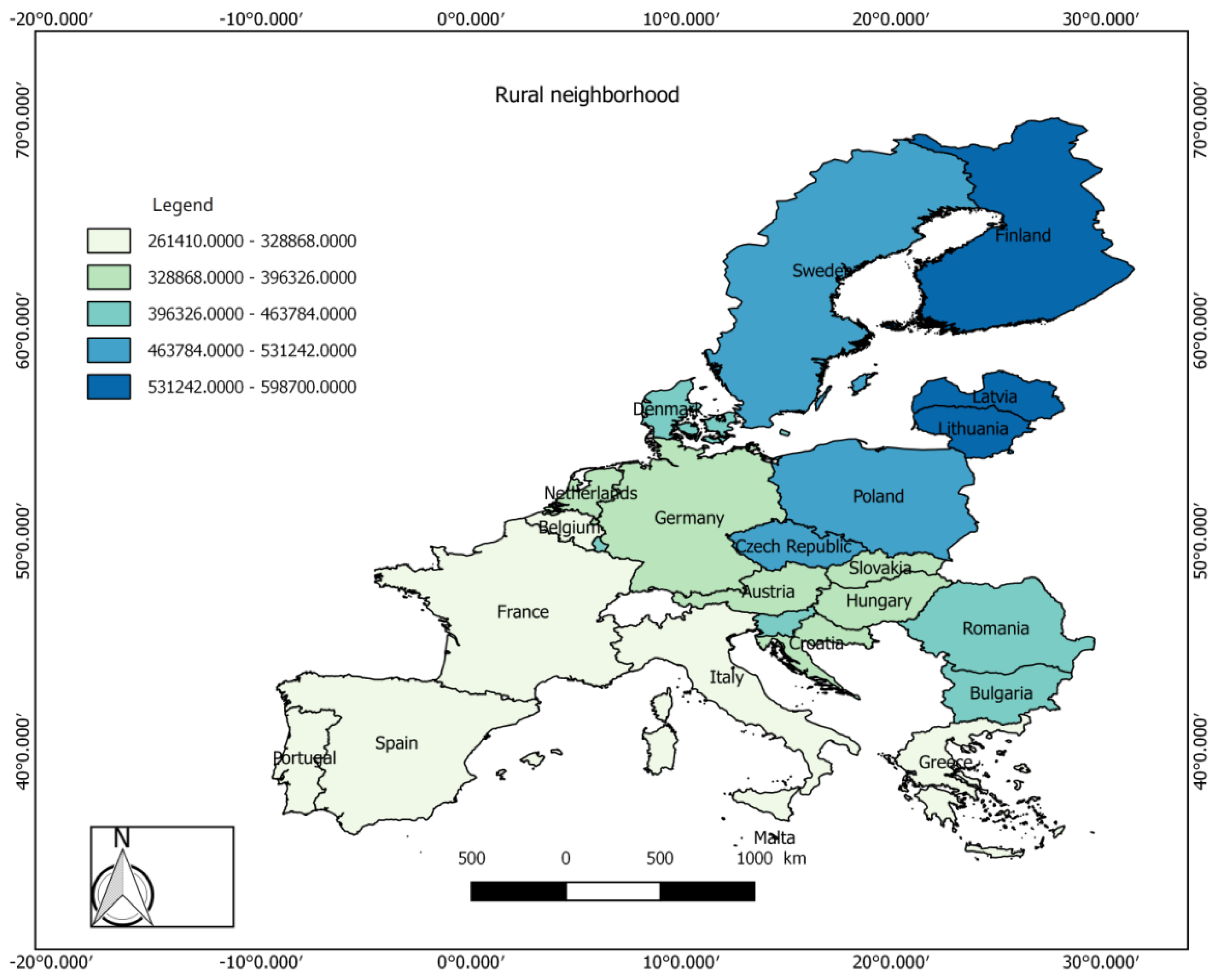

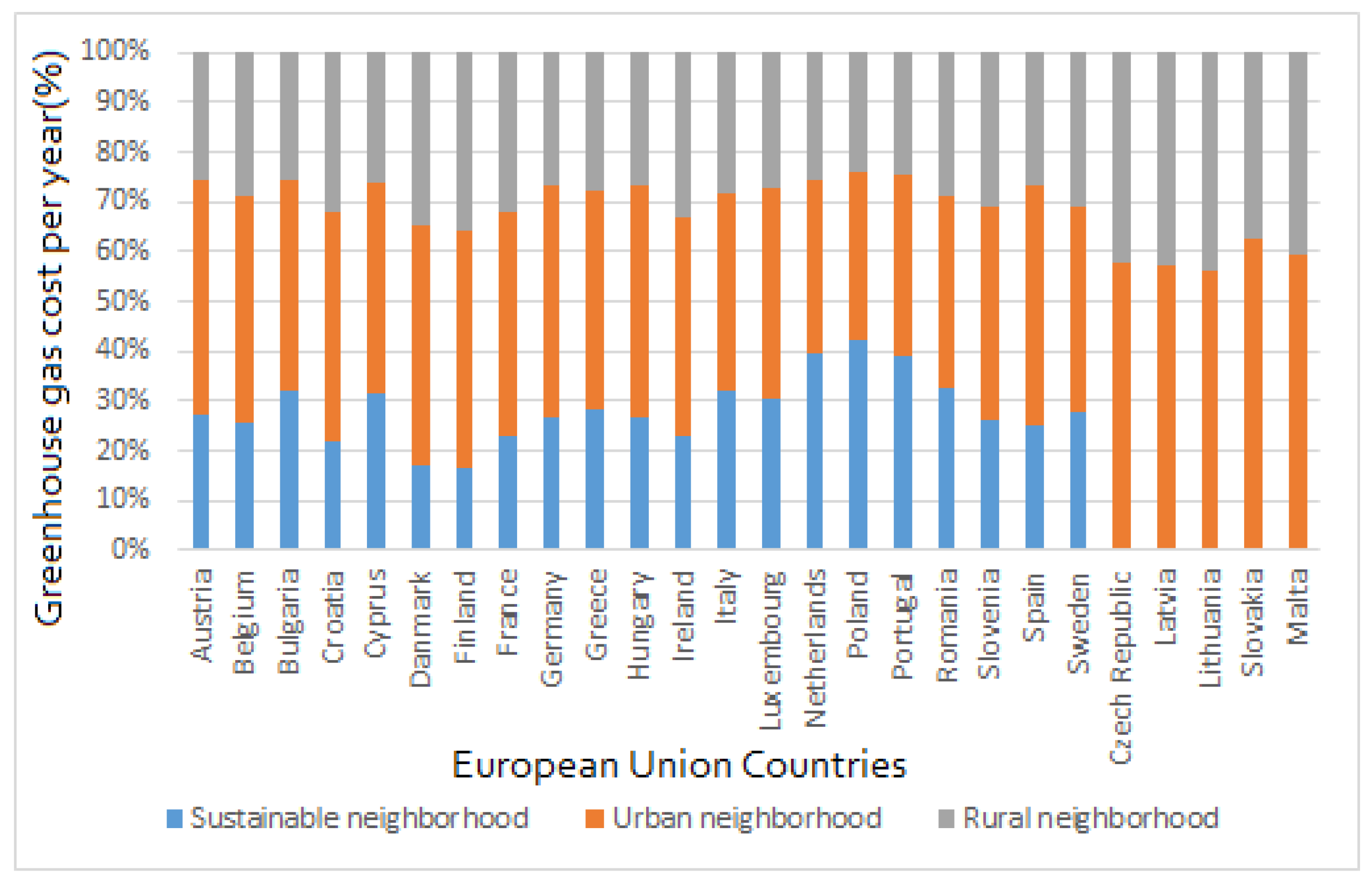
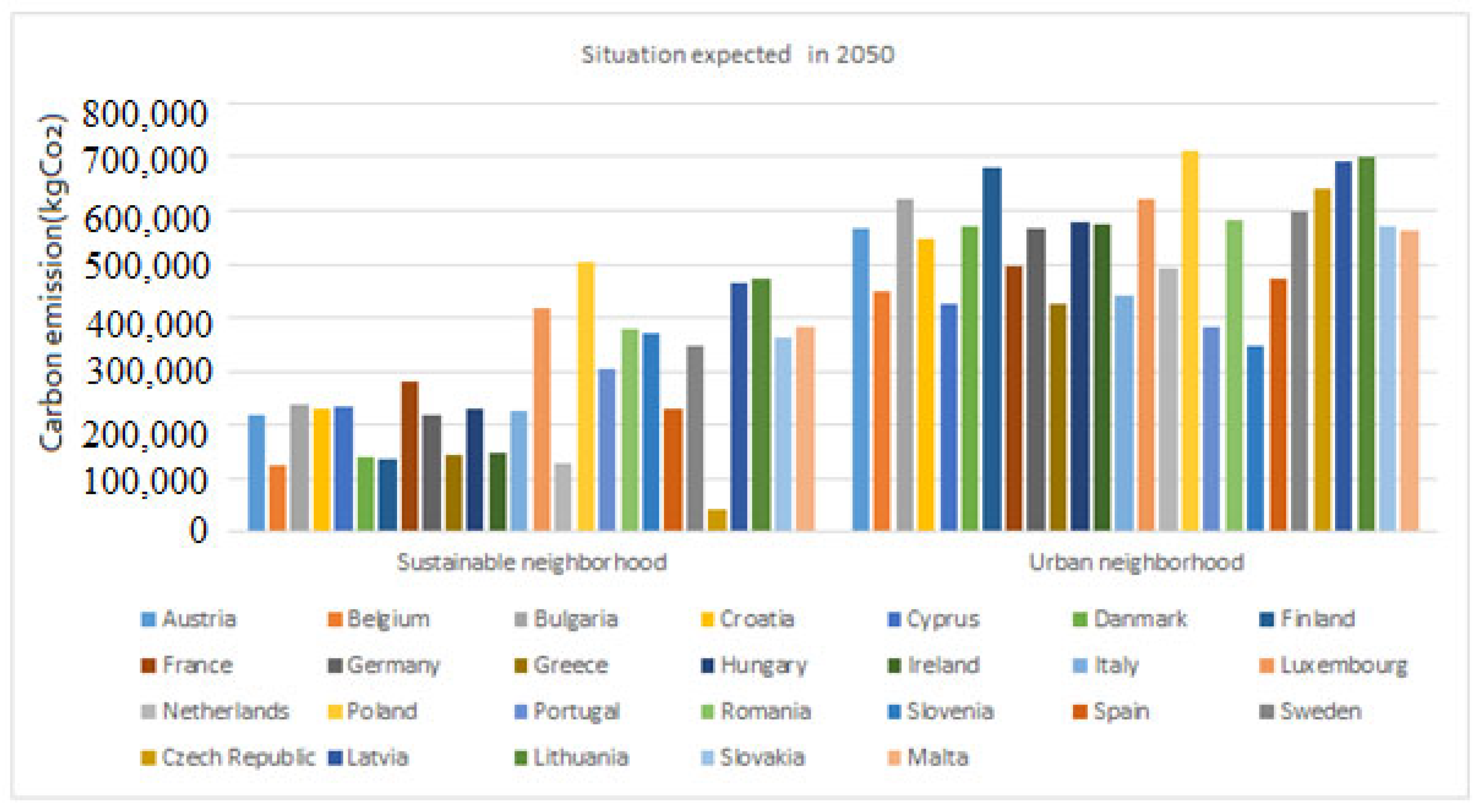
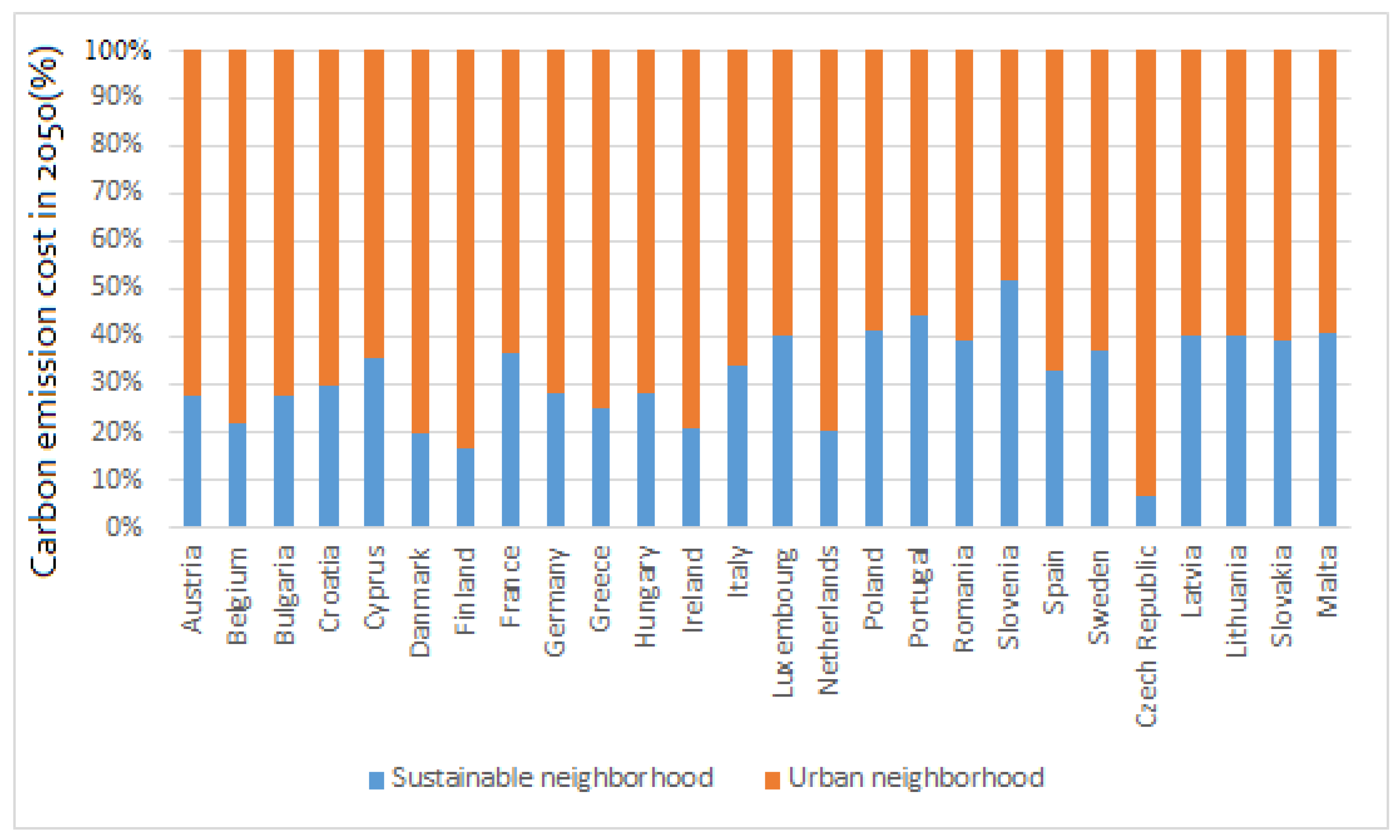



| Type of Community | Eco-Friendly | Metropolitan | Countryside |
|---|---|---|---|
| Land area (m2) | 35,480 | 8726 | 19,457 |
| Inhabitants | 220 | 100 | 30 |
| Structures | 20 | 30 | 40 |
| Single-family homes | 10% | 7% | 75% |
| Twin houses | 60% | 17% | 19% |
| Row houses | 25% | 75% | 4% |
| Flats | 5% | 1% | 2% |
| Compactness | 6 units/ha | 35 units/ha | 20 units/ha |
| % of land occupied by structures | 18% | 44% | 10% |
| Environmental Metric | Unit | Value EUR/Unit |
|---|---|---|
| Greenhouse gases | kg CO2eq | 0.050 |
| Energy consumption | kWh | 0.200 |
| Environmental Metrics | Lotteau et al. [27] | This Research |
|---|---|---|
| GHG (kgeqCO2/m2 Floor area/year) | 11.0–123.0 | 7.5–35.1 |
| Countries | Sustainable Neighborhood: Greenhouse Gas (kgCO2eq/Year/m2) | Rural Neighborhood: Greenhouse Gas (kgCO2eq/Year/m2) | Urban Neighborhood: Greenhouse Gas (kgCO2eq/Year/m2) | |||
|---|---|---|---|---|---|---|
| Living Area | Floor Area | Living Area | Floor Area | Living Area | Floor Area | |
| Austria | 50.0 | 12.3 | 140.0 | - | 190.0 | 18.7 |
| Belgium | 30.0 | 9.6 | 120.0 | 180.0 | 17.6 | |
| Bulgaria | 90.0 | 19.6 | 170.0 | 260.0 | 25.5 | |
| Croatia | 40.0 | 9.2 | 130.0 | - | 230.0 | 22.1 |
| Cyprus | 50.0 | 11.5 | 110 | - | 160.0 | 15.4 |
| Denmark | 30.0 | 7.5 | 150.0 | - | 260.0 | 25.6 |
| Finland | 40.0 | 8.7 | 170.0 | - | 320.0 | 31.0 |
| France | 30.0 | 7.5 | 100.0 | - | 170.0 | 17.0 |
| Germany | 60.0 | 11.7 | 140.0 | - | 190.0 | 18.9 |
| Greece | 50.0 | 11.0 | 120.0 | - | 180.0 | 17.6 |
| Hungary | 50.0 | 11.4 | 140.0 | - | 190.0 | 18.8 |
| Ireland | 40.0 | 10.1 | 130.0 | - | 240.0 | 24.0 |
| Italy | 60.0 | 12.9 | 110.0 | - | 190 | 18.5 |
| Luxembourg | 80.0 | 17.4 | 160.0 | - | 260.0 | 25.4 |
| Netherlands | 90.0 | 19.4 | 120.0 | - | 210.0 | 20.4 |
| Poland | 140 | 32.3 | 170.0 | - | 300.0 | 29.6 |
| Portugal | 60.0 | 14.3 | 90.0 | - | 150.0 | 14.8 |
| Romania | 70.0 | 16.3 | 130.0 | - | 240.0 | 23.8 |
| Slovenia | 60.0 | 12.6 | 140.0 | - | 250.0 | 24.5 |
| Spain | 40.0 | 9.0 | 120.0 | - | 160.0 | 15.5 |
| Sweden | 70.0 | 14.8 | 150.0 | - | 280.0 | 27.4 |
| Countries | Sustainable Neighborhood | Urban Neighborhood |
|---|---|---|
| Rate of Increase of Total CO2 Emission Cost by 2050 (%) | Rate of Increase of Total CO2 Emission Cost by 2050 (%) | |
| Austria | 38.8 | 6.7 |
| Belgium | 54.3 | 9.6 |
| Bulgaria | 58.1 | 16.1 |
| Croatia | 12.9 | 3.7 |
| Cyprus | 29.7 | 4.6 |
| Denmark | 34.9 | 9.1 |
| Finland | 45.4 | 6.9 |
| France | 29.8 | 17.2 |
| Germany | 35.4 | 4.3 |
| Greece | 55.0 | 0.1 |
| Hungary | 30.0 | 2.4 |
| Ireland | 48.9 | 4.3 |
| Italy | 39.2 | 9.2 |
| Luxembourg | 16.9 | 1.2 |
| Netherland | 77.4 | 3.8 |
| Poland | 46.2 | 1.4 |
| Portugal | 26.2 | 4.6 |
| Romania | 19.3 | 42.0 |
| Slovenia | 1.5 | 5.3 |
| Spain | 12.4 | 13.1 |
| Countries | Scenario (0) (Initial District): Greenhouse Gas Emission (GHG) (kgCO2·year) | Scenario (1) Percentage of Reduction in GHG After PV | Scenario (2) Percentage of Reduction in GHG After (Combining Global Warming Measures, Full Building Renovation (100%), 100% Electric Vehicles, and Solar Panels) |
|---|---|---|---|
| Austria | 470,540.0 | 10.1% | 90.4% |
| Belgium | 404,005.0 | 9.4% | 89.5% |
| Bulgaria | 595,680.0 | 14.1% | 91.4% |
| Croatia | 479,685.0 | 13.9% | 90.0% |
| Cyprus | 360,600.0 | 23.5% | 88.5% |
| Denmark | 539,455.0 | 18.0% | 90.7% |
| Finland | 641,210.0 | 8.6% | 91.5% |
| France | 361,810.0 | 9.0% | 88.1% |
| Germany | 463,840.0 | 8.2% | 90.2% |
| Greece | 400,645.0 | 29.8% | 89.1% |
Disclaimer/Publisher’s Note: The statements, opinions and data contained in all publications are solely those of the individual author(s) and contributor(s) and not of MDPI and/or the editor(s). MDPI and/or the editor(s) disclaim responsibility for any injury to people or property resulting from any ideas, methods, instructions or products referred to in the content. |
© 2025 by the authors. Licensee MDPI, Basel, Switzerland. This article is an open access article distributed under the terms and conditions of the Creative Commons Attribution (CC BY) license (https://creativecommons.org/licenses/by/4.0/).
Share and Cite
Kameni Nematchoua, M.; Rakotomalala, M.S.; Reiter, S. Carbon Neutrality and Resilient Districts, a Common Strategy in European Union Countries in 2050. Atmosphere 2025, 16, 508. https://doi.org/10.3390/atmos16050508
Kameni Nematchoua M, Rakotomalala MS, Reiter S. Carbon Neutrality and Resilient Districts, a Common Strategy in European Union Countries in 2050. Atmosphere. 2025; 16(5):508. https://doi.org/10.3390/atmos16050508
Chicago/Turabian StyleKameni Nematchoua, Modeste, Minoson Sendrahasina Rakotomalala, and Sigrid Reiter. 2025. "Carbon Neutrality and Resilient Districts, a Common Strategy in European Union Countries in 2050" Atmosphere 16, no. 5: 508. https://doi.org/10.3390/atmos16050508
APA StyleKameni Nematchoua, M., Rakotomalala, M. S., & Reiter, S. (2025). Carbon Neutrality and Resilient Districts, a Common Strategy in European Union Countries in 2050. Atmosphere, 16(5), 508. https://doi.org/10.3390/atmos16050508






